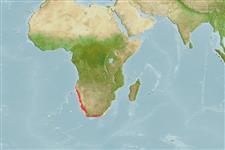Holocéfalos (quimeras) (chimaeras) >
Chimaeriformes (Chimaeras) >
Callorhinchidae (Plownose chimaeras)
Etymology: Callorhinchus: Tautonymous with Chimaera callorynchus Linnaeus 1758 (but unnecessarily emended from -rynchus to -rhinchus: callum (L.), hard skin; rhynchus (L.), snout, referring to peculiar hoe-shaped proboscis (See ETYFish); capensis: -ensis, Latin suffix denoting place: Cape of Good Hope, type locality (See ETYFish).
More on author: Duméril.
Issue
Needs revision.
Environment: milieu / climate zone / depth range / distribution range
Ecología
marino demersal; rango de profundidad 10 - 374 m (Ref. 5578), usually 10 - 200 m (Ref. 3180). Subtropical; 17°S - 35°S, 11°E - 34°E
Southeast Atlantic: Namibia to the Cape and Natal in South Africa (Ref. 5578, 58304).
Length at first maturity / Tamaño / Peso / Age
Maturity: Lm 49.6 range ? - ? cm
Max length : 122 cm TL macho / no sexado; (Ref. 3180); peso máximo publicado: 5.3 kg (Ref. 40637)
Short description
Claves de identificación | Morfología | Morfometría
Espinas dorsales (total) : 1. An elephant fish with a hoe-like snout and arched caudal fin (Ref. 5578). Silvery or bronzy with brown markings on flanks and head; fin webs brown (Ref. 5578).
Found from close inshore and shallow bays to the slope (Ref. 5578). Feeds on small fish and a wide variety of invertebrates (Ref. 27121). Oviparous (Ref. 50449). Produces egg-cases that are spindle shaped, with broad horizontal flanges (Ref. 36731). This species is known to host on its gills monogenean parasites Callorhynchocotyle callorhynchi (Manter, 1955) (Hexabothriidae) and Callorhynchicola multitesticulatus Manter, 1955 (Chimaericolidae) on its gills (Ref. 124045, 124046). Sold commercially as 'silver trumpeter' (Ref. 3180) and considered a delicacy in southern Africa (Ref. 27121). Minimum depth reported from Ref. 7403.
Life cycle and mating behavior
Madurez | Reproducción | Puesta | Huevos | Fecundidad | Larva
Krefft, G., 1990. Callorynchidae. p. 117. In J.C. Quero, J.C. Hureau, C. Karrer, A. Post and L. Saldanha (eds.) Check-list of the fishes of the eastern tropical Atlantic (CLOFETA). JNICT, Lisbon; SEI, Paris; and UNESCO, Parisl. Vol. 1. (Ref. 7403)
IUCN Red List Status (Ref. 130435: Version 2024-1)
Threat to humans
Traumatogenic (Ref. 12484)
Human uses
Pesquerías: escaso valor comercial; pesca deportiva: si
Herramientas
Special reports
Download XML
Fuentes de Internet
Estimates based on models
Preferred temperature (Ref.
123201): 10.3 - 21, mean 16.2 °C (based on 200 cells).
Phylogenetic diversity index (Ref.
82804): PD
50 = 0.7500 [Uniqueness, from 0.5 = low to 2.0 = high].
Bayesian length-weight: a=0.00389 (0.00180 - 0.00842), b=3.12 (2.94 - 3.30), in cm total length, based on all LWR estimates for this body shape (Ref.
93245).
Nivel trófico (Ref.
69278): 3.5 ±0.52 se; based on food items.
Generation time: 21.3 ( na - na) years. Estimated as median ln(3)/K based on 2
growth studies.
Resiliencia (Ref.
120179): Bajo, población duplicada en un tiempo mínimo de 4.5-14 años (Fec assumed to be <100).
Fishing Vulnerability (Ref.
59153): High vulnerability (59 of 100).
Climate Vulnerability (Ref.
125649): Moderate to high vulnerability (50 of 100).
Nutrients (Ref.
124155): Calcium = 27.3 [7.3, 78.0] mg/100g; Iron = 0.819 [0.288, 3.576] mg/100g; Protein = 14.1 [11.0, 18.4] %; Omega3 = 0.255 [0.106, 0.572] g/100g; Selenium = 38.9 [8.7, 103.3] μg/100g; VitaminA = 6.42 [2.18, 18.02] μg/100g; Zinc = 0.549 [0.281, 1.037] mg/100g (wet weight);
